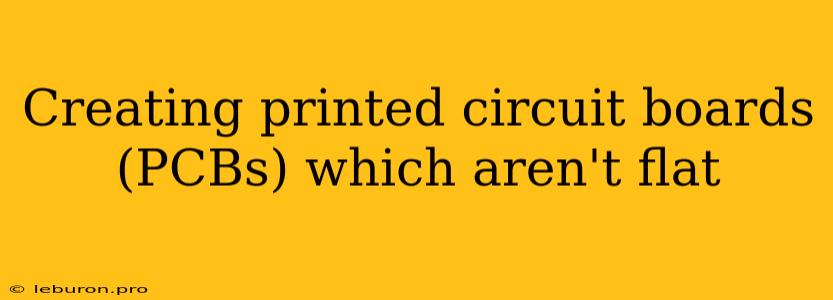Creating printed circuit boards (PCBs) is a fundamental process in electronics manufacturing, enabling the interconnection of electronic components. Traditionally, PCBs have been flat, offering a two-dimensional platform for circuit design. However, the ever-increasing complexity and miniaturization of electronic devices are driving the development of non-flat PCBs, opening up new possibilities for design and functionality. This article delves into the realm of non-flat PCBs, exploring their advantages, fabrication techniques, and applications.
Beyond Flatness: The Rise of Non-Flat PCBs
The limitations of traditional flat PCBs are becoming increasingly apparent in modern electronics. As devices become more compact and feature-rich, the need for innovative solutions to accommodate complex circuit layouts and component placement arises. Non-flat PCBs, also known as flex-rigid PCBs, flexible PCBs, or conformable PCBs, offer a compelling alternative by overcoming the constraints of flatness. These PCBs can be bent, folded, or contoured to conform to specific shapes and sizes, enabling the design of compact, adaptable, and aesthetically pleasing electronic devices.
Advantages of Non-Flat PCBs
The adoption of non-flat PCBs is driven by numerous advantages over traditional flat PCBs:
- Flexibility: Non-flat PCBs can be bent, folded, or curved, allowing them to conform to complex shapes and surfaces. This flexibility is crucial for designing compact, space-saving devices and enabling unique form factors.
- Space Optimization: Non-flat PCBs enable the integration of electronic components in tight spaces and unconventional layouts, maximizing the utilization of available space and reducing overall device size.
- Improved Durability: The flexibility of non-flat PCBs makes them more resistant to bending and flexing, enhancing their durability and resilience in challenging environments.
- Aesthetics: Non-flat PCBs can enhance the aesthetics of electronic devices by allowing for contoured surfaces and integrated designs, creating a more visually appealing and modern look.
Fabrication Techniques for Non-Flat PCBs
The fabrication of non-flat PCBs involves specialized techniques that differ significantly from those used for flat PCBs. These techniques ensure the desired flexibility, conductivity, and overall integrity of the circuit board.
1. Flexible Substrate Materials
The foundation of non-flat PCBs lies in the use of flexible substrate materials. These materials provide the necessary flexibility to bend and conform to various shapes. Common flexible substrate materials include:
- Polyimide (PI): Known for its high temperature resistance and excellent electrical insulation properties.
- Polyester (PET): Offers good flexibility, cost-effectiveness, and chemical resistance.
- FR-4 with Flex Layer: A combination of the rigid FR-4 material with a flexible layer, allowing for the creation of flex-rigid PCBs.
2. Manufacturing Processes
The manufacturing processes for non-flat PCBs involve adaptations to traditional PCB fabrication techniques. These adaptations ensure the integrity of the conductive tracks and the preservation of flexibility throughout the manufacturing process.
- Lamination: The flexible substrate is laminated with copper foil, creating the conductive layers for the circuit.
- Etching: Unwanted copper is etched away, leaving behind the desired circuit patterns.
- Drilling: Holes are drilled through the substrate for component mounting and interconnection.
- Plating: Conductive plating is applied to the copper tracks and vias to enhance electrical conductivity.
- Soldering: Components are soldered to the circuit board, ensuring electrical connections.
3. Design Considerations
The design of non-flat PCBs presents unique challenges compared to flat PCBs. Careful consideration of the following factors is essential:
- Bend Radius: The minimum bend radius, or the smallest radius the PCB can be bent without damage, should be specified for the chosen substrate material.
- Component Placement: The placement of components should minimize stress on the PCB during bending.
- Trace Width and Spacing: The width and spacing of the conductive tracks should be adjusted to accommodate the flexing of the board.
- Layer Stackup: The number and order of layers in the PCB can affect its flexibility and overall design.
Applications of Non-Flat PCBs
Non-flat PCBs have found their way into a wide range of applications across various industries.
1. Consumer Electronics
- Smartphones and Wearables: Non-flat PCBs enable the development of slim, foldable, and flexible mobile devices, enhancing user experience and design aesthetics.
- Headsets and Speakers: Flexible PCBs are used to create compact, comfortable, and durable audio devices with contoured shapes.
2. Automotive
- Infotainment Systems: Non-flat PCBs are employed in the design of curved displays and integrated touchscreens in vehicles.
- Sensors and Actuators: Flexible sensors and actuators based on non-flat PCBs are used in automotive applications for vehicle diagnostics, safety systems, and comfort features.
3. Healthcare
- Medical Devices: Non-flat PCBs are used in wearable medical devices, such as heart rate monitors, fitness trackers, and patient monitoring systems.
- Prosthetics and Orthotics: Flexible PCBs enable the development of advanced prosthetics and orthotics with improved functionality and comfort.
4. Aerospace and Defense
- Aircraft Electronics: Non-flat PCBs are used in the development of lightweight and durable avionics systems.
- Military Equipment: Flexible PCBs are utilized in military applications where ruggedness, flexibility, and space constraints are crucial.
Conclusion
Non-flat PCBs are revolutionizing the way electronic devices are designed and manufactured. Their flexibility, space optimization, and durability offer significant advantages over traditional flat PCBs. As technology continues to advance, non-flat PCBs are poised to play a crucial role in the development of innovative and sophisticated electronic devices across various industries. Their adaptability, coupled with the versatility of their fabrication techniques, promises to unlock new possibilities for design and functionality, shaping the future of electronics.
